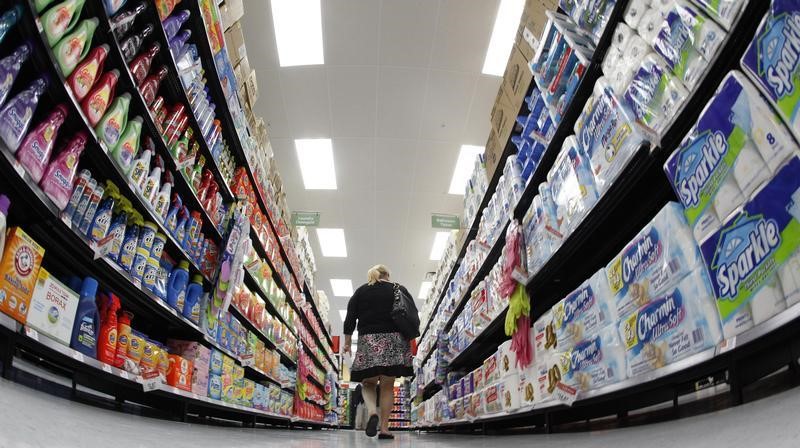By Lucia Mutikani
WASHINGTON (Reuters) - U.S. consumer prices unexpectedly fell in December as the cost of gasoline dropped and rents rose moderately, signs of weak inflation that further diminish expectations of a Federal Reserve interest rate hike in March.
Other data on Wednesday showed a drop in housing starts and building permits last month, adding to weak reports on retail sales, industrial production, exports, inventory and manufacturing surveys that have suggested a significant slowdown in economic growth at the end of 2015.
Against the backdrop of renewed weakness in oil prices, which touched new lows on Wednesday, economists say the expected reversion to the Fed's 2 percent inflation target is slowing.
"The broad-based nature of the decline in inflation will hardly be encouraging news at the Fed, and if anything it is likely to temper their confidence in the outlook for inflation," said Millan Mulraine, deputy chief economist at TD Securities in New York.
The Labor Department said its Consumer Price Index slipped 0.1 percent after being unchanged in November. Despite that drop, the CPI increased 0.7 percent in the 12 months through December, the biggest rise in a year. That followed a 0.5 percent gain in November.
Economists had forecast the CPI remaining unchanged last month and rising 0.8 percent from a year ago.
The year-over-year inflation rate is rising as oil price-driven weak readings in 2015 drop out of the calculation. The boost from the so-called base effects could, however, be limited by lower oil prices, which are near 12-year lows.
Consumer prices increased 0.7 percent in 2015, the second smallest December-December gain in the last 50 years, after rising 0.8 percent in 2014.
The so-called core CPI, which strips out food and energy costs, edged up 0.1 percent in December after advancing 0.2 percent in each of the prior three months.
In the 12 months through December, the core CPI increased 2.1 percent, the largest gain since July 2012, after climbing 2.0 percent in November. The Fed tracks a price measure that is running well below the core CPI.
FALLING FOOD PRICES
U.S. Treasuries were trading higher, while the dollar slipped against a basket of currencies. U.S. stocks fell, tracking lower oil prices.
Market-based measures of Fed policy expectations assigned a probability of 29 percent to the central bank's raising rates at the March 15-16 meeting, according to the CME Group's FedWatch program. The Fed raised its benchmark overnight interest rate in December by 25 basis points to between 0.25 percent and 0.50 percent, the first hike in almost a decade.
Last month, gasoline tumbled 3.9 percent after falling 2.4 percent in November. Food prices fell for a second straight month, with meat, poultry, fish and eggs prices posting their biggest decline since August 1979.
The gain in the core CPI was kept in check by moderate increases in rents and medical care costs. Rents rose 0.2 percent after a similar gain in November.
"Faltering rent inflation ... signals the loss of economic momentum. That momentum moved millennials off of their parent's couch and onto their own, but momentum may no longer be strong enough to put the same upward pressure on rents," said Steve Blitz, chief economist at ITG Investment Research in new York.
Medical care costs edged up 0.1 percent, slowing from a 0.4 percent rise in November. The costs of doctor visits were unchanged after jumping 1.1 percent the prior month.
A strong dollar as well as an inventory bloat is dampening prices for some core goods. Apparel prices declined for a fourth straight month, while prices for new motor vehicles dipped 0.1 percent.
In a separate report, the Commerce Department said housing starts dropped 2.5 percent to a seasonally adjusted annual pace of 1.15 million units as groundbreaking on both single- and multi-family projects fell.
The impact of unseasonably warm weather was likely offset by heavy rains in some parts of the country. Starts rose 10.3 percent last year to their highest level since 2007.
Building permits declined 3.9 percent to a 1.23 million-unit rate in December, pulled down by an 11.4 percent plunge in permits for multi-family buildings. Permits for the construction of single-family homes rose 1.8 percent last month.
Gregory Daco, head of U.S. macroeconomics at Oxford Economics in New York, said fundamentals are still giving muscle to the housing market.

"Slowly strengthening wage growth, solid employment gains, the gradual release of pent-up demand, and still-low mortgage rates all underpin our expectation of a continued strengthening in housing activity over the course of 2016," he said.